
 |
The two main events in the annual calendar of Japanese tradition are Obon  , in August, and the period from the last days of the year, called Kure , in August, and the period from the last days of the year, called Kure  , through the few days of the New Year, called Shoogatsu , through the few days of the New Year, called Shoogatsu  . Both are occasions when it is customary to pay back debts or return things borrowed, give gifts to people with whom one has pecial ties or indebtedness, gather with family members living far away, and generally to settle whatever
affairs have been pending in one way or other. The expression " Bon-Kure-Shoogatsu, " then, stands for the particular rituals and customs that are observed for these occasions as well as this tradition of closure of the old and readyness/celebration of the new. " A Day in the Life " featured Obon in no13 and nengajoo in no12 of The Japan Forum Newsletter. How do Japanese spend Kure, the final days of the year ? . Both are occasions when it is customary to pay back debts or return things borrowed, give gifts to people with whom one has pecial ties or indebtedness, gather with family members living far away, and generally to settle whatever
affairs have been pending in one way or other. The expression " Bon-Kure-Shoogatsu, " then, stands for the particular rituals and customs that are observed for these occasions as well as this tradition of closure of the old and readyness/celebration of the new. " A Day in the Life " featured Obon in no13 and nengajoo in no12 of The Japan Forum Newsletter. How do Japanese spend Kure, the final days of the year ? The end of the year is an extremely busy time for everyone. Grown-ups are intent on tidying up unfinished business, organizing cluttered offices, and finishing off uncompleted projects. It is the occasion for the once-a-year thorough cleaning of homes, and for shopping and preparation for the celebrations of the New Year. Children, too, get involved in the activity, and are expected to help with cleaning and errands. The end of the year is an extremely busy time for everyone. Grown-ups are intent on tidying up unfinished business, organizing cluttered offices, and finishing off uncompleted projects. It is the occasion for the once-a-year thorough cleaning of homes, and for shopping and preparation for the celebrations of the New Year. Children, too, get involved in the activity, and are expected to help with cleaning and errands. In this issue, we look at how busy people become with preparations for the end of the year, the tension of trying to get everything done in order to be ready for the traditional observances, and the excited anticipation of the coming New Year, Japan's toshikoshi season. In this issue, we look at how busy people become with preparations for the end of the year, the tension of trying to get everything done in order to be ready for the traditional observances, and the excited anticipation of the coming New Year, Japan's toshikoshi season.
|
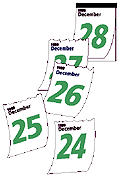 Winter Vacation Begins: Winter Vacation Begins: Back Home from Work and School As the end of the year approaches, workplaces and schools enter a flurry of activity. Executives and sales representatives of many companies pay final respects of the year to clients and business partners, offering gifts of calendars or datebooks for the coming year. Offices are cleaned and desks completely tidied. The end of the year is all more hectic because it is the deadline for completing projects and contracts and for the closing of accounts. On top of that, December is the season for boonenkai  , " forget-the-year " parties at which workmates, classmates, and friends gather to recall the ups-and-downs of the past year and cement ties. Government offices officially close ( shigoto-osame , " forget-the-year " parties at which workmates, classmates, and friends gather to recall the ups-and-downs of the past year and cement ties. Government offices officially close ( shigoto-osame  ) on December 28th, but companies and other workplaces go on vacation on different dates. ) on December 28th, but companies and other workplaces go on vacation on different dates. In public schools in Japan, cleaning of classrooms and corridors is routinely done by the students. Extra time is set aside for the year-end " big cleaning " ( oosooji In public schools in Japan, cleaning of classrooms and corridors is routinely done by the students. Extra time is set aside for the year-end " big cleaning " ( oosooji  ) prior to winter vacation, when the floors are scrubbed with extra care, the blackboards are washed, and windows shined. Vacuum cleaners are used in homes, but at school, all the cleaning is done with broom and dustpan and mops made from used towels ( zookin ) prior to winter vacation, when the floors are scrubbed with extra care, the blackboards are washed, and windows shined. Vacuum cleaners are used in homes, but at school, all the cleaning is done with broom and dustpan and mops made from used towels ( zookin  ). ). On the last day of school, the students gather in their homerooms and wait for their report cards to be handed out. Once that tense moment is over, they can look forward to the holiday.There are differences from one prefecture to another, but this year, winter vacation will extend in most cases from December 25 to January 10. On the last day of school, the students gather in their homerooms and wait for their report cards to be handed out. Once that tense moment is over, they can look forward to the holiday.There are differences from one prefecture to another, but this year, winter vacation will extend in most cases from December 25 to January 10.
| ||
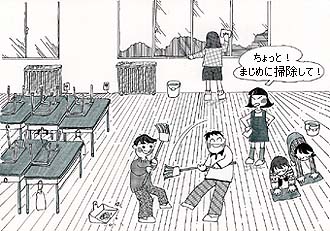 " Hey, you guys ! Get back to work ! " |
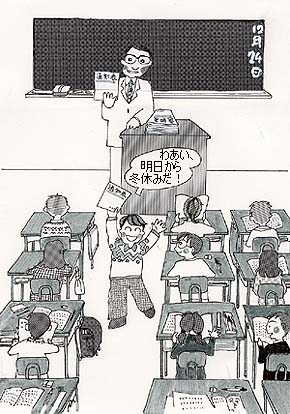 " Yay ! Vacation starts tomorrow ! " |
|
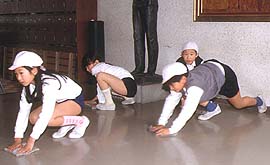 Mopping the floors with zookin. |
||
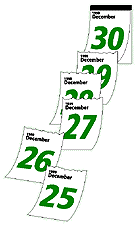 Year-end / New Year Preparations Year-end / New Year PreparationsOOsooji For the household, " year-end cleaning " is a regular and major event, for tradition dictates that a house should be made immaculate in preparation for greeting the New Year. So widely established is this custom that sales of cleaning supplies and television commercials for cleaning equipment invariably increase during these busy weeks. Special care is taken to clean parts of the house not ordinarily given much attention throughout the year, such as ceilings, ventilation fans, woodwork, and corners behind furniture. In some families, the chores are divided up among family members and the furniture is moved out to wipe the walls and floors ; windows are washed and shined, the paper on the shooji panels is changed, and the family car is washed. When the cleaning is done and house has been tidied, the entranceway to the house is scrubbed and sprinkled with water, and special New Year's festoons are set out in the entrance hall and main rooms elsewhere in the house, and even attached to the car. Oosooji is naturally the best way to get rid of the dust and dirt that has accumulated over the past year, but is also a helpful occasion to take account of those things left undone and organize one's affairs. That process makes it easier to get a fresh start in the New Year. | |
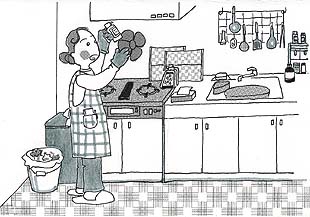 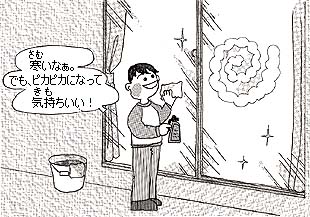 " Whew ! It's cold. But it sure is nice to have clean windows again! " |
Father : " Look here, I found the book I was looking for. Hey, remember this ? " Mother : " Now, Dad, you mustn't start reading those books! We've got to get the cleaning done ! " 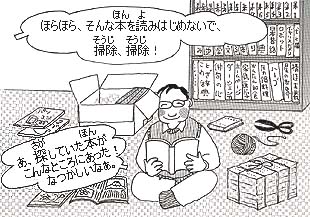 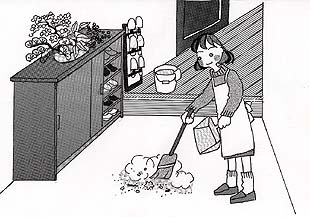
|
Writing nengajoo  Most people write nengajoo New Year's cards to send to their friends, acquaintances, workmates and relatives to express gratitude, good wishes, and hopes for continued friendship and goodwill during the New Year. Nengajoo can be posted anytime, but are delivered all at once, on the morning of January 1. Cards posted by December 24th are assured of delivery on New Year's morning, but many people end up writing most of their nengajoo after their vacation begins. ( See The Japan Forum Newsletter, no12 ) |
Shopping and Cooking |
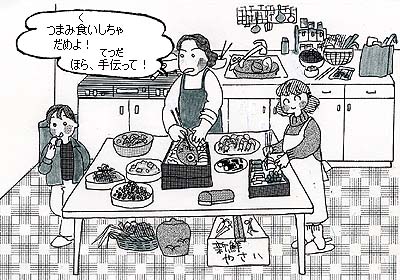 " No nibbling on the New Year's food! Come on! Why don't you help us instead! " |
The year end also brings a greater-than-usual flurry of shopping. Extra cleaning supplies are always needed for oosooji, and stocks must be laid up of o-mochi and ingredients of special New Year's dishes. In many cases the only shops open for the first three days of the New Year will be convenience stores, so it is necessary to buy anything needed for those days beforehand. Shops and department stores are intensely crowded at this time of year.  The foods traditionally eaten at New Year's, called o-sechi ryoori The foods traditionally eaten at New Year's, called o-sechi ryoori  , are prepared in the last days of the year. Made with strong seasonings so that they will keep for several days over the holidays, o-sechi ryori also give housewives a brief respite from their labors. New Year's foods vary from one part of the country to another, but generally include yasai no nimono ( stewed vegetables ), kuromame ( sweet boiled black beans ), kazunoko ( salted herring roe ), tai ( sea bream ), and ebi ( shrimp ), all attractively arranged in square lacquered boxes called juubako. Almost all o-sechi foods are chosen for the association of their names with certain meanings, virtues or fortunes to be sought. The name of the fish tai overlaps with the word medetai, " auspicious, " " propitious, " " joyous, "etc. and since its pink color, too, is close to the lucky color red, it is grilled and served whole with the festive dishes for the occasion. In recent years, younger people are increasingly uninterested in preserving the o-sechi traditions. , are prepared in the last days of the year. Made with strong seasonings so that they will keep for several days over the holidays, o-sechi ryori also give housewives a brief respite from their labors. New Year's foods vary from one part of the country to another, but generally include yasai no nimono ( stewed vegetables ), kuromame ( sweet boiled black beans ), kazunoko ( salted herring roe ), tai ( sea bream ), and ebi ( shrimp ), all attractively arranged in square lacquered boxes called juubako. Almost all o-sechi foods are chosen for the association of their names with certain meanings, virtues or fortunes to be sought. The name of the fish tai overlaps with the word medetai, " auspicious, " " propitious, " " joyous, "etc. and since its pink color, too, is close to the lucky color red, it is grilled and served whole with the festive dishes for the occasion. In recent years, younger people are increasingly uninterested in preserving the o-sechi traditions. For the three days of New Year's it is traditional to replace boiled rice ( gohan ) with grilled o-mochi rice cakes and miso-shiru with a soup made of o-mochi and vegetables boiled in clear stock, zooni For the three days of New Year's it is traditional to replace boiled rice ( gohan ) with grilled o-mochi rice cakes and miso-shiru with a soup made of o-mochi and vegetables boiled in clear stock, zooni  , to fill out meals centering around the traditional foods served in the juubako. O-mochi can be purchased in stores, but especially in the country, households often make a supply of their own to last the holidays. , to fill out meals centering around the traditional foods served in the juubako. O-mochi can be purchased in stores, but especially in the country, households often make a supply of their own to last the holidays.
|
 Oomisoka Oomisoka  "New Year's Eve" "New Year's Eve"Toshikoshi soba  "Year-crossing soba" "Year-crossing soba" | |
| Soba, or buckwheat noodles, customarily eaten on New Year's Eve, are called " year-crossing soba. " There are various theories about the origin of this custom, but essentially it is associated with the prayer for a happy and prosperous New Year. Every household has a different custom: some boil and serve soba at home, others take time out of their busy preparations to go out to eat at a nearby soba shop, and still others order delivery of prepared soba from a local shop. New Year's Eve is the soba shop's busiest time of year. | 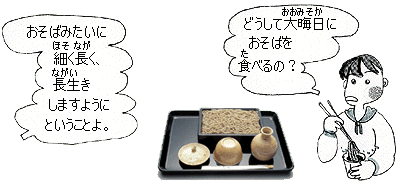 Brother: "Why do we eat soba at New Year's?" Mother: "They say so it's you'll live long like a noodle!" |
| Traditional Television Programs The main feature of New Year's Eve television viewing is the Koohaku Uta Gassen ( " Red vs White Singing Battle " ), broadcast from 8:00 to 11:45 at night on the public channel, NHK ( Japan National Broadcasting ). It is a long-running program that celebrates its fiftieth anniversary with the end of 1999. Nowadays it is broadcast by satellite, too, making it possible for Japanese and people of Japanese descent or background living overseas to enjoy the nostalgia and atmosphere of New Year's Eve in their own tradition.  The songfest takes the form of a competition between two teams of popular female ( the Red team ) and male ( the White team ) singers. They take turns performing hit tunes and a panel of judges, along with votes from the audience, decides the winner. In recent years, a variety of other attractive year-end television programs has been broadcast, so the viewer ratings for the Koohaku Uta Gassen has declined to about 60 percent, but it is a favorite program for thinking back over the passing year and celebrating its close. The songfest takes the form of a competition between two teams of popular female ( the Red team ) and male ( the White team ) singers. They take turns performing hit tunes and a panel of judges, along with votes from the audience, decides the winner. In recent years, a variety of other attractive year-end television programs has been broadcast, so the viewer ratings for the Koohaku Uta Gassen has declined to about 60 percent, but it is a favorite program for thinking back over the passing year and celebrating its close.
|
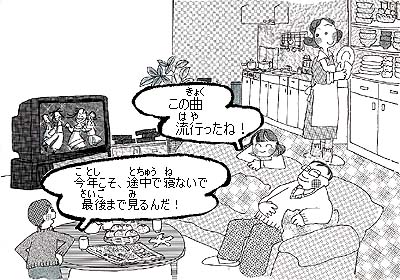 Big sister: "This song was a great hit, wasn't it." Brother: "I always fall asleep halfway through. This year I want to see it all the way to the end! " |
 |
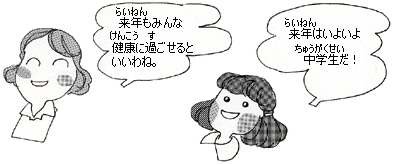 Father : "This year is finally over." Mother : "I hope we all keep our health next year too." Big sister : "I'm going to be a junior high school student next year." |
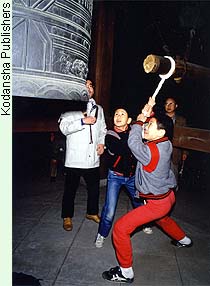 |
Joya no kane  Joya means New Year's eve, and joya no kane is the 108 tolls of the bell at Buddhist temples starting before 12:00 midnight on the last night of the year. It is believed that with each tolling of the bell one of the 108 evil passions from which humans suffer -- greed, anger, hatred, etc. -- is driven away. Each ringing of the bell takes away some of the impurity and ugliness of the passing year, cleansing us in readiness for the New Year. When the joya no kane begins to toll, the atmosphere of New Year's Eve changes completely, from bustle and excitement to quietude and solemnity. The mood in which people greet the New Year is quite different from the extravagant celebrations with toasts and firecrackers that are common in Western countries. As the temples begin to ring out the old year, many people set out to pay their first visit of the year to temples and shrines, hatsumoode  . Some people go to famous places to see the first dawn of the New Year, hatsu hinode . Some people go to famous places to see the first dawn of the New Year, hatsu hinode  . Temples and shrines all over the country are filled with people and trains run throughout the night to serve hatsumoode travelers. . Temples and shrines all over the country are filled with people and trains run throughout the night to serve hatsumoode travelers.Many people go back to spend New Year's with their parents, often to parents and grandparent's houses in the countryside. In recent years, it has become popular to escape the hectic year-end season by planning family trips overseas. Ways of spending the holiday have greatly diversified, with young people making it the occasion for year-end / New Year's parties or skiing trips with their friends. For families with a high-school senior who is cramming for the university entrance examinations that take place from mid-January to late February, however, New Year's is usually celebrated in very quiet style. |
2000
Junuary 1
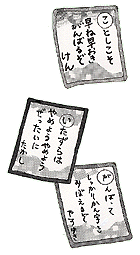 |
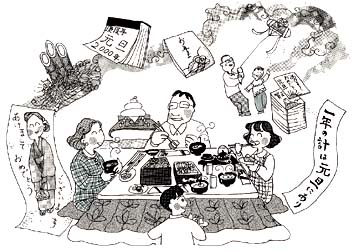 |
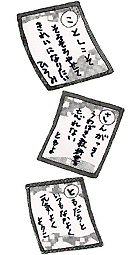 |
for A Happy New Year
The Japan Forum
| Illustrations : Asayama Yuki |
| Original text : The Japan Forum Newsletter no15 "A day in The Life" December 1999. |
Send feedback to forum@tjf.or.jp